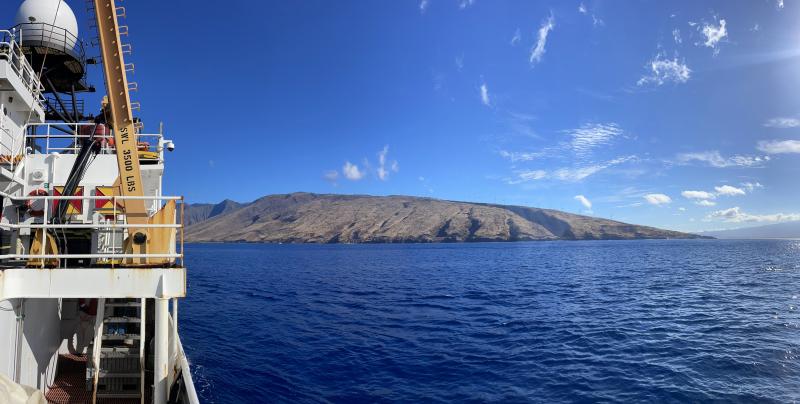What is that big white ship on the horizon? What are they doing out there? Looking for Deep 7 bottomfish (ʻōpakapaka, onaga, ehu, gindai, kalekale, lehi, and hāpuʻupuʻu)!
For the past 2 years, cooperative research fishers from the Pacific Islands Fisheries Group and Lynker Technologies have cooperatively conducted the Bottomfish Fishery-Independent Survey in Hawai‘i (BFISH). We cannot thank them enough for their dedicated efforts and hard work during these challenging years.
This year, the NOAA Ship Oscar Elton Sette hosted the research project to conduct stereo-video camera surveys around the islands of Niʻihau, Kauaʻi, Oʻahu, Molokaʻi, and Maui Nui. As in years past, cooperative research fishers deployed the same camera systems around Hawaiʻi Island, Maui Nui, and Molokaʻi.
The NOAA Pacific Islands Fisheries Science Center has conducted BFISH annually since 2016. The goal of the survey is to provide fishery-independent estimates of bottomfish abundance for use in the Deep 7 bottomfish stock assessment.
From September 11 through October 3, the Oscar Elton Sette housed NOAA scientists who deployed deep-water camera systems at 100 locations around the main Hawaiian Islands. They conducted research and development operations aimed at developing an artificial lighting system to extend the depth range of the cameras without disturbing the bottomfish community. Working from Niʻihau to Maui, these scientists spent their days aboard the Sette as well as its 19-foot launches, deploying their cameras into bottomfish depths (75–250 meters, 250–800 feet, 40–140 fathoms). Each camera sat on the seafloor for 15 minutes before being recovered and deployed in a new location. No gear is left on the bottom. At the end of the survey, a team of researchers at the Pacific Islands Fisheries Science Center will analyze the video data to identify, count, and measure bottomfish.
Cooperative research operations began July 31, 2022, and are expected to run through mid-November. At that point fishers will have completed 400 research fishing and 100 camera surveys. They deploy hook-and-line gear in a standardized way across the full depth range of the stock (75–400 meters, 250–1,300 feet, 40–220 fathoms). They report the size and species of each fish they catch, and provide their catch to the Pacific Islands Fisheries Science Center Life History Program. The Program uses these samples to determine growth rates, the size at which fish reach sexual maturity and become spawning capable, and many other life history characteristics. All of this information serves to improve the Deep 7 stock assessment.
After the survey, scientists will combine the video annotations with research fishing catch data to estimate bottomfish abundance and biomass. By using this information they continually improve the Deep7 stock assessment. They provide managers with the best available information to set commercial catch limits and help ensure a sustainable Deep7 fishery in the Hawaiian Islands.
Rare school of Lehi (Aphareus rutilans) seen by the MOUSS underwater camera system. Credit: NOAA Fisheries.
Learn more about the BFISH survey:
- Hawai'i's Deep 7 Fishery - Part 1
- Hawai'i's Deep 7 Fishery - Part 2
- Hawai'i's Deep 7 Fishery - Part 3
- Hawai'i's Deep 7 Fishery - Part 4







